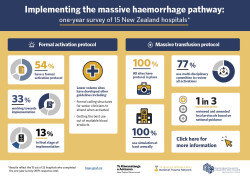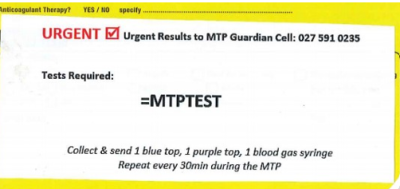December 2021 marked one year since the publication of the National Trauma Network and Te Tāhū Hauora Health Quality & Safety Commission’s national best practice critical bleeding bundle of care.
Te Tāhū Hauora has carried out a survey of trauma-receiving hospitals across Aotearoa New Zealand to gauge how the guidance has been used in practice and what changes services have made to manage the care of critically haemorrhaging trauma patients.
Thank you to everyone who completed the survey. We received responses from 15 of the 23 hospitals surveyed, giving us an overall response rate of 65 percent. Of these responses:
- 54 percent have a formalised activation protocol for critical haemorrhage in place at their hospital, with another 2 sites (13 percent) in the final stages of implementation
- the remaining sites (33 percent) are in the working group phase with the intention to implement a policy in future.
The others are situated at smaller hospitals with lower trauma volumes and less available resources.
In addition to having a formal activation protocol, the lower-volume sites have put in place other appropriate guidelines including agreed calling structures to get senior decision-makers to the bedside and a massive transfusion protocol (MTP) designed to make best use of available blood product.
All 15 sites (100 percent) have an MTP in place, and one-third of sites have reviewed their protocol and made amendments to their MTPs in line with the guidance document.
It is positive to see almost 77 percent of the 15 sites have a multi-disciplinary committee review all patients with traumatic critical haemorrhage who meet criteria for protocol activation. This is a recommended action for quality assurance and learning purposes.
Bedside ultrasound and fluid warmer capability in emergency departments (EDs) was consistently excellent across the country, however, it was more common for theatres rather than EDs to use rapid infusers.
 The availability of TEG or ROTEM was limited to tertiary trauma centres or large regional trauma centres.
The availability of TEG or ROTEM was limited to tertiary trauma centres or large regional trauma centres.
All 15 sites that responded reported critical haemorrhage simulation training exercises were carried out at least annually in their EDs and most hospitals also carried out simulation training for theatre staff. The NetworkZ training was seen as especially invaluable for this.
You can view an infographic of the results here (157KB, pdf).
Site-specific quality improvement initiatives
Several excellent quality improvement initiatives are now in place across the country to improve care and outcomes for critically bleeding trauma patients. Some examples are given below (district health board (DHB) names are used as the health districts at the time had not yet transitioned to Te Whatu Ora).
Supporting peripheral hospitals
Northland DHB implemented its Code Crimson system at Whangārei Hospital in June 2021. Also, due to the large geographical spread across the Northland DHB region, work is underway to help peripheral hospitals that feed into Whangārei with the availability and safe storage some of the critical initial blood products listed in the guidance (fresh frozen plasma and cryoprecipitate). This work includes a successful capital expenditure case for a blood product freezer for Bay of Islands Hospital.
Code red
Since 2018 Te Manawa Taki (Midland) region has developed and used a patient reception system called Code Red. The system contains all essential elements of the critical haemorrhage bundle as well as pathways for the management of critical brain injury. The in-hospital protocols are consistent with regional destination policy and communications requirements, making patient flow seamless.
Code Red system is gradually being implemented through education and clinical exposure across the Te Manawa Taki hospitals. Advice from the national working group has been incorporated into revision of the MTPs and fine-tuned for use in regional facilities. Code Red and associated processes and algorithms are described in the Te Manawa Taki Trauma System’s Midland Trauma Guidelines (www.midlandtrauma.nz).
Tiered trauma calls
MidCentral already has a two-tiered trauma call system in place and uses this to include many of the Code Crimson principles into its red/critical tier. This allows staff to operate under an already-familiar system rather than introducing an additional protocol.
Code Crimson checklists
Christchurch Hospital has recently published its Code Crimson draft protocol, including changes to the MTP in line with bundle guidance. The protocol also includes a Code Crimson quick reference checklist for ED staff to guide role allocation and equipment and drug preparation for incoming patients, as well as outlining resuscitation priorities for the team once the patient arrives in ED.
MTP coordinator
Both Auckland City and Middlemore hospitals are developing a designated MTP coordinator role within their systems to improve efficiency and safety when an MTP is in use.
Blood bank documentation
 The team at Dunedin Hospital have been working with their blood bank to create both an MTP-specific simplified fluid balance chart and a laboratory request sticker (pictured) to streamline the MTP repeat blood test process and make the process more efficient for staff.
The team at Dunedin Hospital have been working with their blood bank to create both an MTP-specific simplified fluid balance chart and a laboratory request sticker (pictured) to streamline the MTP repeat blood test process and make the process more efficient for staff.
Future work
Many survey respondents said they would like to see ambulance services incorporate some of the bundle guidance into their clinical practice guidelines because it would give pre-hospital staff more opportunity and confidence to recommend activation of the critical haemorrhage protocol prior to hospital arrival.
Several smaller hospitals who responded also said they lacked resources to implement this work. To address this, they suggested creating working groups of similar-sized centres to share ideas, and for the tertiary trauma hospitals to help their regional colleagues where possible to create cohesive guidelines.
Te Tāhū Hauora Health Quality & Safety Commission and the National Trauma Network will look for opportunities within the workstream to support these ideas.
